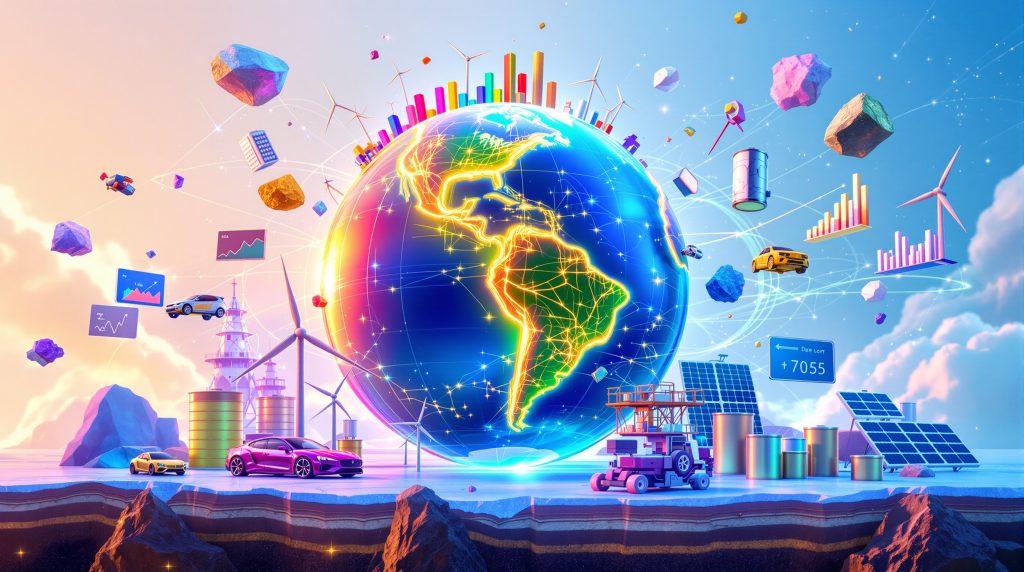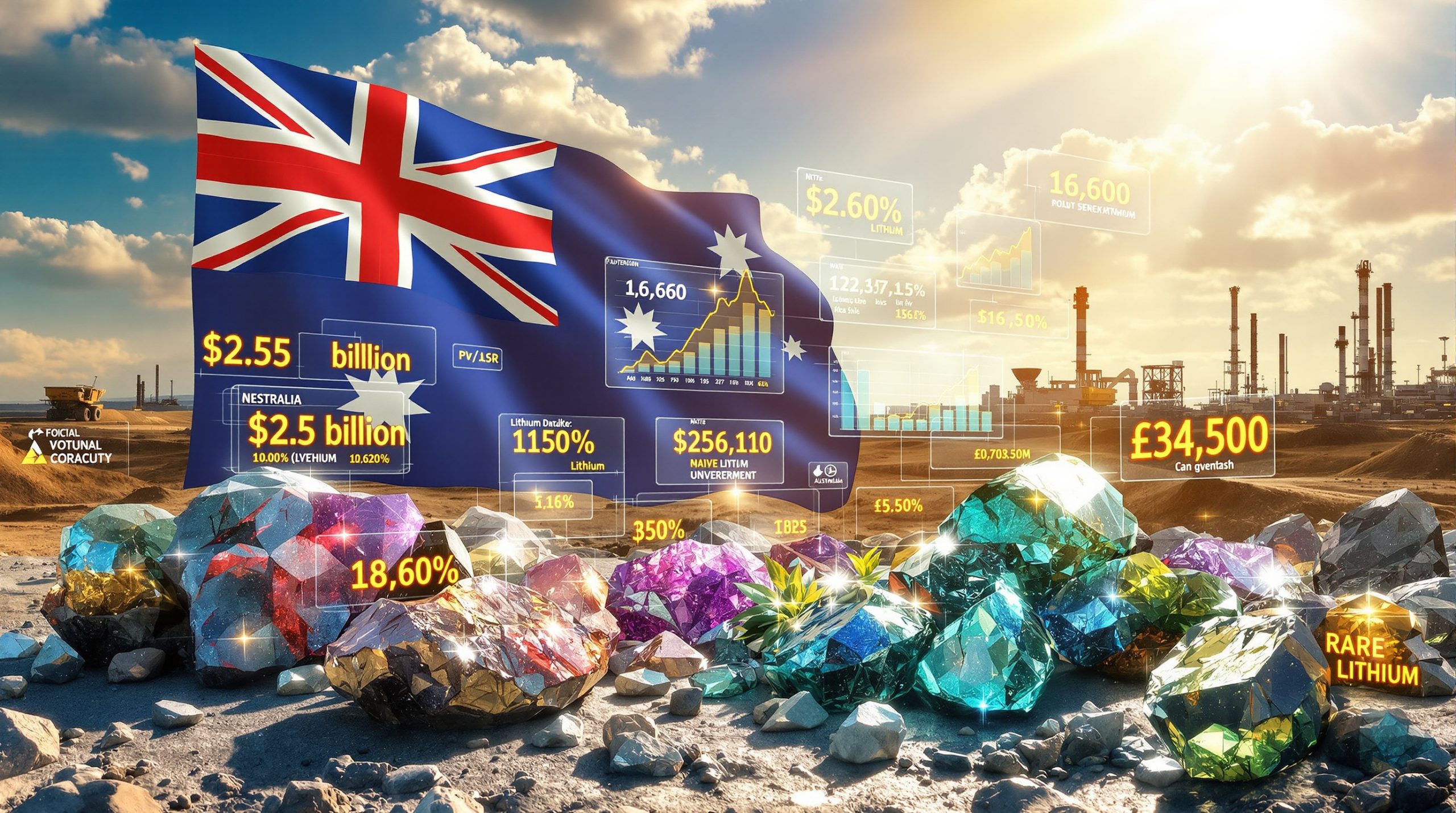Critical minerals in energy transition represent the fundamental building blocks enabling our shift toward renewable energy systems. These specialized materials possess unique properties essential for clean energy technologies, characterised by their supply vulnerability and strategic economic importance. Furthermore, understanding the critical minerals energy transition landscape is crucial for investors and policymakers alike.
Unlike traditional commodities such as oil or steel, critical minerals face significant supply chain risks due to geographic concentration of production and limited global processing capabilities. Lithium, cobalt, nickel, copper, and rare earth elements form the backbone of technologies that cannot easily substitute these materials without substantial performance compromises.
The strategic importance of these materials extends beyond simple economic metrics. Recent discussions at international forums highlight their central role in energy transformation. South African government officials confirmed that critical minerals dominated G20 energy transitions group meetings in October 2025, with broad agreement that energy transition will be fundamentally driven by access to these materials.
Understanding Critical Minerals and Their Role in Modern Energy Systems
Key Characteristics Defining Critical Minerals
Critical minerals exhibit several defining characteristics that separate them from conventional raw materials:
• High economic importance for deploying clean energy infrastructure at scale
• Supply chain vulnerabilities stemming from concentrated production sources
• Limited substitutability in critical applications without performance degradation
• Strategic national security implications for energy independence
Consequently, these characteristics make critical minerals essential for any comprehensive investing guide 2025 strategy.
How Critical Minerals Enable Global Energy Transformation
The fundamental shift toward renewable energy systems demands mineral-intensive technologies requiring substantially more raw materials than conventional fossil fuel infrastructure. This transformation creates unprecedented demand for specific minerals across multiple technology categories.
Technology-Specific Mineral Dependencies
| Clean Energy Technology | Primary Critical Minerals Required | Mineral Intensity vs Conventional Energy |
|---|---|---|
| Electric Vehicle Batteries | Lithium, cobalt, nickel, graphite | 6x more minerals than internal combustion engines |
| Wind Power Generation | Rare earth elements, copper, steel | 9x more minerals than natural gas plants |
| Solar Photovoltaic Systems | Silver, silicon, copper, aluminum | 4x more minerals than gas-fired generation |
| Grid-Scale Energy Storage | Lithium, vanadium, cobalt | 16x more minerals than conventional backup power |
Data compiled from International Energy Agency clean energy transition analyses
The scale of mineral requirements becomes apparent when examining individual technologies. A single electric vehicle battery demands approximately 8 kilograms of lithium, 35 kilograms of nickel, 20 kilograms of manganese, and 14 kilograms of cobalt. Meanwhile, offshore wind installations require 15 times more minerals than equivalent fossil fuel generation capacity, primarily for copper wiring, rare earth permanent magnets, and specialised steel components.
Digital Technology Integration Complexity
The clean energy transition involves more than traditional power generation equipment. Modern renewable energy systems increasingly rely on microprocessor and digital technologies for optimisation and control. Wind farms, battery storage systems, and smart grid infrastructure all depend on sophisticated digital control systems requiring additional critical minerals beyond their primary energy functions.
This digital dependency creates a secondary layer of mineral demand often overlooked in traditional analyses. Semiconductor manufacturing, essential for renewable energy control systems, requires 17 different rare earth elements alongside specialised materials like gallium, germanium, and indium.
Explosive Demand Growth Projections for Critical Minerals
Unprecedented Scale of Demand Increases
International Energy Agency forecasts reveal dramatic demand growth trajectories through 2040 across key critical minerals:
Lithium: 42-fold increase driven primarily by electric vehicle battery production and grid-scale energy storage deployment
Graphite: 25-fold increase for battery anode materials in both automotive and stationary applications
Cobalt: 21-fold increase for high-performance battery cathode chemistry requirements
Nickel: 19-fold increase supporting battery energy density improvements and stainless steel demand
Rare Earth Elements: 7-fold increase for permanent magnet applications in wind turbines and electric motors
These projections assume successful achievement of global climate targets requiring massive clean energy infrastructure deployment. The scale represents the largest raw material demand surge in modern industrial history.
Regional Demand Distribution Patterns
Asia-Pacific Region: Dominates global battery manufacturing capacity and leads electric vehicle adoption rates, creating concentrated regional demand
North America: Focuses on grid modernisation and renewable energy deployment with emphasis on supply chain localisation
Europe: Pursues aggressive decarbonisation targets through industrial electrification and renewable energy mandates
Emerging Markets: Emphasises electricity access expansion and clean energy infrastructure development
Recent data from South Africa illustrates regional energy transformation challenges. The country's electricity sector expects continued growth with no job losses anticipated, as decarbonisation efforts require both traditional and clean electricity generation. This dual requirement creates complex mineral demand patterns beyond simple renewable energy deployment.
Critical Vulnerabilities in Mineral Supply Chains
Geographic Concentration Creating Systemic Risk
Critical mineral supply chains exhibit extreme geographic concentration that creates significant vulnerabilities for global energy transition efforts. However, Australia's minerals reserve strategy offers one approach to addressing these challenges.
China's Dominant Processing Position:
• 60% of global lithium processing and refining capacity
• 80% of rare earth element separation and purification
• 70% of battery-grade mineral processing facilities
• 75% of lithium-ion battery cell manufacturing capacity
Regional Mining Concentration Patterns:
• Lithium Production: Australia (52%), Chile (25%), China (13%)
• Cobalt Extraction: Democratic Republic of Congo (70%), Russia (4%), Australia (3%)
• Rare Earth Mining: China (60%), United States (16%), Myanmar (11%)
Processing Bottlenecks as Primary Constraints
While mining operations can scale relatively quickly with sufficient investment, establishing processing and refining facilities represents the most significant constraint in critical mineral supply chains. New refining capacity development typically requires:
• 5-10 year development timelines from project conception to commercial production
• Specialised technical expertise concentrated in relatively few countries globally
• Capital investments ranging from $1-5 billion per major processing facility
• Environmental permitting processes that can extend project timelines significantly
These processing constraints create strategic vulnerabilities even when diversified mining sources exist. Raw material extraction represents only the first step in complex value chains requiring sophisticated industrial infrastructure.
National and International Policy Response Strategies
United States Strategic Initiatives
The Inflation Reduction Act, while enacted under the previous administration, continues influencing critical mineral policies through 2025. Key provisions include substantial clean energy investment incentives, tax benefits for domestic mineral processing development, and frameworks for strategic partnerships with allied nations producing critical minerals.
However, the current political landscape may affect implementation priorities and funding allocations for these programs. Fast-track permitting processes for strategic mineral projects remain under policy review.
European Union Critical Raw Materials Framework
The European Union's Critical Raw Materials Act establishes ambitious targets including 10% domestic production requirements by 2030 and 25% recycling targets for key strategic minerals. The €3 billion European Raw Materials Alliance represents significant funding for supply chain development initiatives.
Strategic partnerships with resource-rich nations form a cornerstone of EU policy, emphasising diversification away from concentrated supply sources while building processing capabilities within European borders.
Australian Resource Development Strategy
Australia's $2 billion Critical Minerals Facility focuses on developing domestic processing capabilities beyond traditional raw material exports. The strategy emphasises value-added manufacturing, research partnerships with international institutions, and export market diversification programs.
International Cooperation Mechanisms
The Minerals Security Partnership coordinates supply chain resilience efforts among major economies through:
• Joint infrastructure investment in processing facilities across multiple countries
• Shared technical standards and certification systems for sustainable mining practices
• Coordinated strategic stockpiling approaches for supply security
• Alternative supply route development reducing single-point-of-failure risks
Environmental Impact Challenges in Mineral Extraction
Water Resource Consumption and Scarcity
Critical mineral extraction operations often occur in water-stressed regions, creating significant environmental pressures that complicate sustainable development efforts. In addition, addressing these challenges requires comprehensive mining sustainability transformation approaches.
Lithium Brine Operations:
• Consume approximately 500,000 gallons of water per ton of lithium produced
• Concentrated primarily in arid South American salt flat regions
• Impact local groundwater systems and fragile desert ecosystem balance
Copper Mining Water Requirements:
• Require 200-300 tons of water per ton of refined copper
• Generate acid mine drainage risks affecting watershed quality
• Compete with agricultural and municipal water needs in mining regions
Biodiversity and Ecosystem Disruption
Expanding mineral extraction threatens sensitive ecosystems across multiple continents:
• Deep-sea mining for polymetallic nodules containing cobalt and rare earth elements risks disrupting unknown marine ecosystems
• Rainforest operations in the Amazon basin threaten biodiversity hotspots while accessing mineral deposits
• Desert mining activities disrupt fragile arid ecosystem balance with long-term recovery challenges
Environmental impact assessments increasingly recognise these trade-offs between clean energy deployment and ecosystem preservation, requiring more sophisticated approaches to sustainable mineral extraction.
Circular Economy Solutions for Supply Constraints
Battery Recycling Recovery Potential
End-of-life battery recycling represents a growing opportunity to address critical mineral supply constraints. Moreover, implementing effective battery recycling solutions becomes increasingly vital. Industry projections suggest recycling could provide significant mineral recovery by 2040:
• Lithium recovery potential: 25% of projected total demand through advanced recycling technologies
• Cobalt recovery rates: 35% of demand addressable through battery recycling programs
• Nickel recovery capacity: 20% of total demand recoverable from spent battery materials
Urban Mining Resource Opportunities
Electronic waste streams contain concentrated critical minerals often exceeding natural ore grades:
• Rare earth concentrations in smartphones contain 17 different strategic elements in accessible forms
• Gold content in electronic waste typically runs 40-50 times higher than primary mining ore grades
• Platinum group metals from automotive catalytic converters offer readily recoverable material streams
Design Innovation for Material Circularity
Emerging design approaches aim to reduce primary mineral demand through improved circularity:
• Modular battery architectures enabling easier disassembly and component recovery
• Digital material passports tracking mineral content throughout product lifecycles
• Product-as-a-service models retaining manufacturer ownership to optimise material recovery
• Standardised component designs across manufacturers facilitating recycling efficiency
Technological Alternatives Reducing Mineral Dependencies
Next-Generation Battery Chemistry Development
Research into alternative battery technologies shows promise for reducing critical mineral requirements:
Sodium-ion Battery Systems: Eliminate lithium and cobalt requirements entirely while using abundant sodium resources globally
Iron-air Energy Storage: Utilise widely available iron materials for long-duration grid storage applications
Solid-state Battery Technology: Reduce overall material requirements by 30-40% compared to conventional lithium-ion designs
Aluminum-ion Batteries: Leverage abundant aluminum resources though commercial viability remains under development
Strategic Material Substitution Advances
Material science research enables strategic substitutions across clean energy technologies:
• Rare earth-free electric motors using advanced ferrite magnet designs with comparable performance
• Copper alternatives including specialised aluminum alloys and carbon fibre conductors
• Cobalt-free battery cathodes using iron phosphate chemistry with improved safety characteristics
• Synthetic graphite production replacing natural graphite sources through advanced manufacturing
These technological developments remain largely in research phases, with commercial deployment timelines varying significantly across different applications.
Geopolitical Implications of Critical Mineral Control
Resource Diplomacy Evolution
Critical minerals fundamentally reshape international relationships through new forms of resource diplomacy:
• Strategic bilateral partnerships between consuming nations and mineral-producing countries
• Technology transfer agreements providing processing capabilities in exchange for supply security
• Investment protection treaties safeguarding mineral supply chain infrastructure investments
• Trade agreement provisions incorporating mineral security alongside traditional economic considerations
Emerging Geopolitical Power Dynamics
Countries controlling critical mineral resources gain enhanced international leverage comparable to historical oil producer influence:
• Chile and Argentina dominate lithium triangle resources controlling global lithium supply fundamentals
• Democratic Republic of Congo holds majority global cobalt reserves creating supply concentration risks
• Indonesia rapidly expands nickel processing capacity while implementing export restrictions
• Australia maintains diverse critical mineral portfolio across multiple strategic materials
The South African context illustrates these dynamics, as the country balances energy security needs with climate commitments. Government officials acknowledge the complex challenge of maintaining current energy supply while transitioning to lower-carbon systems, requiring careful diplomatic and economic balancing.
Investment Landscape and Market Opportunities
Market Scale and Growth Trajectory
The critical minerals sector represents unprecedented investment opportunities driven by clean energy transition requirements:
• Current global market value: Estimated at $320 billion across all critical mineral categories
• 2030 projected market size: $750 billion reflecting accelerated clean energy deployment
• Annual growth rates: 12-15% sustained growth expected through 2040
Strategic Investment Categories
Upstream Development Opportunities:
• Exploration and resource development projects in underexplored regions
• Advanced extraction technology deployment improving recovery rates
• Processing and refining facility development reducing geographic concentration
Midstream Infrastructure Investments:
• Battery manufacturing capacity expansion across multiple regions
• Recycling infrastructure development creating circular material flows
• Supply chain logistics optimisation reducing transportation bottlenecks
Downstream Application Markets:
• Energy storage system deployment supporting grid modernisation
• Electric vehicle manufacturing capacity expansion
• Renewable energy project development creating sustained mineral demand
Regional Investment Context
The South African energy sector illustrates investment complexities in emerging markets. The country's oil and gas industry contributes over 250,000 jobs while facing infrastructure challenges including refinery closures and distribution system reliability issues.
This economic reality demonstrates the investment challenge of balancing immediate energy security needs with long-term clean energy transition goals. Countries require substantial capital for both maintaining existing energy systems and building new clean energy infrastructure simultaneously.
Navigating the Critical Minerals Challenge
Critical minerals in energy transition represent both unprecedented opportunity and significant risk for global decarbonisation efforts. The scale of demand growth creates massive market opportunities while supply chain vulnerabilities and environmental concerns require coordinated international responses. Additionally, insights from UNEP's critical energy transition minerals report highlight the urgency of addressing these challenges.
Success in managing this transition depends on several critical factors:
Supply Chain Diversification: Moving beyond current geographic concentrations through strategic partnerships and infrastructure development across multiple regions and countries.
Circular Infrastructure Investment: Creating comprehensive recycling systems that transform waste streams into valuable material inputs, reducing primary extraction pressures.
Alternative Technology Development: Advancing research into materials and technologies that reduce dependencies on the most constrained critical minerals without compromising performance.
Environmental Standards Integration: Ensuring responsible mining practices that balance clean energy deployment with ecosystem protection and social equity.
International Cooperation Frameworks: Building collaborative approaches that share risks, costs, and benefits of critical mineral supply security across multiple stakeholders.
The nations and organisations that successfully navigate these interconnected challenges will secure competitive advantages in the emerging clean energy economy. Those that fail to address supply vulnerabilities, environmental impacts, or technological alternatives risk significant disadvantages in the global energy transformation currently reshaping economic and geopolitical relationships worldwide.
Recent industry discussions emphasise that this transformation requires balancing immediate energy needs with long-term sustainability goals. As energy sector professionals noted at recent conferences, countries face the complex challenge of maintaining current energy supply while simultaneously building the infrastructure necessary for future clean energy systems. This dual requirement creates both investment opportunities and policy challenges that will define the next decade of energy development globally.
Ready to Capitalise on the Critical Minerals Boom?
Discovery Alert's proprietary Discovery IQ model delivers real-time alerts on significant critical mineral discoveries across the ASX, instantly empowering subscribers to identify actionable opportunities ahead of the broader market. Understand why major mineral discoveries can lead to substantial market returns by exploring Discovery Alert's dedicated discoveries page, showcasing historic examples of exceptional outcomes, then begin your 30-day free trial today to position yourself ahead of the market.




